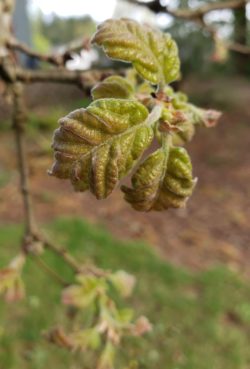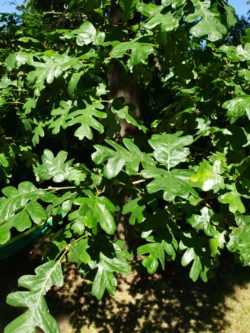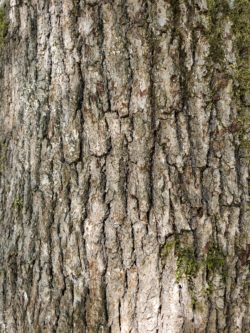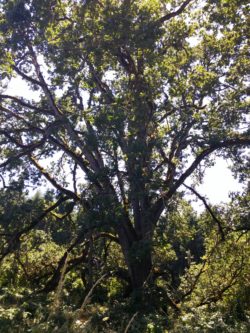
Species Highlight: Oregon White Oak
There are Oregon white oak trees growing in the Willamette valley today that were growing long before European settlement of our area. The Oregon white oak in the photograph above is around 200 years old and grows at Graham Oaks Nature park in Wilsonville. The Oregon white oak (Quercus garryana) is native to Oregon and is important to the ecosystem and history of the Willamette valley.

Oregon White Oak Growth Habit
The form of the Oregon white oak depends heavily on where it grows. The massive trunk, branches, and mushroom-shaped canopy of the mature Oregon white oak are prominent features of the open Willamette valley woodland savanna, as in the main photograph at the beginning of this article. Oregon white oaks grown in crowded forests are taller and more slender in stature, as in the photograph immediately above. The deciduous Oregon white oak is slow growing up to 70 feet with a deep taproot which makes it drought-resistant. It thrives in the heavy clay soils, wet winters, and dry summers of the Willamette valley.


The leaves unfurl in the spring (above, left) and develop into the round-lobed, dark green leaves of summer (above, right), which turn a leathery brown in the fall. The large, smooth acorns of the Oregon white oak are ripe in the fall.
Oregon White Oak In Ecosystem and History
The Oregon white oak is important to the ecosystem and history of the Willamette valley. The Oregon white oak supports many native animal species year-round by providing food, shelter, and good nesting habitat. Native pollinators seek out the flowers of the oak in the early spring. In addition to the many mammals and birds reliant on the acorns of the tree in the fall and winter, nesting birds feed their young the insects that thrive on the oak during the spring breeding season.

The acorns of the Oregon white oak were an important food source to the tribes of the Willamette valley. Because the mature Oregon white oak is less susceptible to fire damage than its competing tree species, the periodic fires that tribes would set to cultivate the land around the trees encouraged the dominance of the Oregon white oak in the valley woodlands.

Several outstanding specimens of Oregon white oak are listed as Oregon Heritage trees, including the 400 year old Signature oak (seen above) which grows in the Oregon Garden in Silverton. To learn more about the Oregon Heritage tree program, which now boasts 75 heritage trees that are historically significant to our state, see our previous blog post.
Conservation of Oregon White Oak
For many reasons, the biodiverse habitats supported by the Oregon white oak are dwindling. Due to its importance to the ecosystem of our area, Metro has conducted a project to map existing oaks in the Portland area to focus their Oregon white oak conservation efforts. Metro and other conservation groups encourage homeowners to plant young trees and preserve existing Oregon white oaks. More information about the Metro Oregon white oak program and an oakscaping guide can be found here.
Oregon White Oak Planting and Care
The Oregon white oak should be planted in full sun, in well-drained soil, with plenty of room to grow. It should be sited 50 feet away from any structures or other trees in order to allow for the full spread of its canopy. The leaf and acorn litter from Oregon white oaks should be considered when planting near walkways and driveways. If you are lucky enough to have a mature Oregon white oak growing on your property, do not irrigate it, as they are susceptible to root rot. Oregon white oaks are typically low maintenance. Our arborists usually recommend pruning every 5-10 years for clearance over roofs and drives, to remove the occasional structural defect, and to remove deadwood that accumulates in the interior of the canopy.
The importance of the Oregon white oak to our local ecosystem and history can not be overstated. Planting and caring for them now could benefit your neighborhood for hundreds of years.


